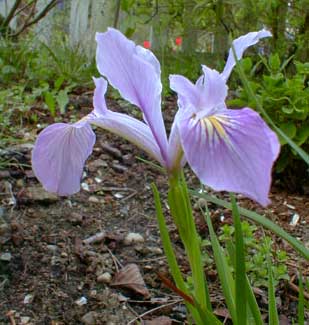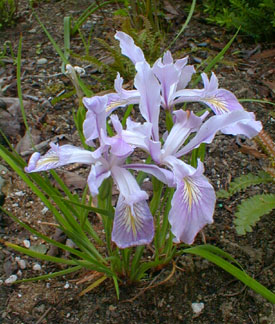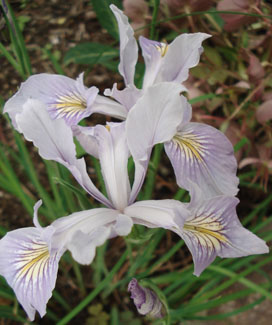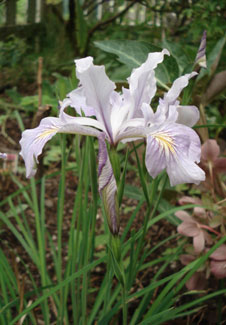
Toughleaf Iris; aka:
Blue Cascade Iris, or
Oregon Flag
"I hear the flowers talking in the dawn;
And where a sunken basin cuts the lawn,
Cinctured with iris, pale and glistening,
The sudden swish
Of a waking fish."
-Amy Lowell
(1874-1925)
(1874-1925)
 This native deciduous Iris was first described in 1825 by botanical explorer David Douglas (1799-1834) during his journey in the Pacific Northwest. Douglas sent seeds to England, where it soon reached gardens.
This native deciduous Iris was first described in 1825 by botanical explorer David Douglas (1799-1834) during his journey in the Pacific Northwest. Douglas sent seeds to England, where it soon reached gardens.It's encountered wild in southwestern Washington state & most of the coast of Oregon, with a yellow variant population (I. tenax klamathensis) in Humbolt county of northern California.
Its range overlaps other native iris species I. douglasiana, I. chrysophylla & I. innominata, with which it hybridizes forming intermediate populations. It does not extend east of the Cascades.
It prefers open woodland environments in dappled sunlight, & often grows near oaks which will not be fully releafed when the iris grass is first up. It does not grow under evergreens that do not permit seasonal light to reach it, but it is sometimes encountered in clearcuts where it tolerates full sun.
Generally it should have neither the fullest sun or the fullest shade, but any error of placement should be made to the sunny side.
An established clump can be surprisingly drought tolerant for a plant that is so often found in marshy meadows, though in the garden it blooms best in moist well draining soil. Ours is on a garden ledge that drains sharply & has had occasional dry spells when I was too depressed or busy to care for everything as well as I should, & this slowly expanding clump just never seems stressed.
 It grows one to two feet tall, but I've seen them in full flower & mature at a stunted height of half a foot or eight inches; ours is never any higher than one foot..
It grows one to two feet tall, but I've seen them in full flower & mature at a stunted height of half a foot or eight inches; ours is never any higher than one foot..Ours is the palest violet-blue, to almost white with violet lines, the same little clump producing flowers of different shades. The little buds are neon blue.
It flowers as early as late March or can start as late as May or early June. The photos on this page were taken in two different years. In 2007 the clump flowered in April & the blooms were blue as they ever get. In 2009 they blumed in June, when they were their palest.
Conditions had changed for them a bit, & I don't know if that accounts for their color varying from year to year. The garden they are in had gotten very dark from surrounding shrubbery & a rapidly growing tree. The tree was removed, & the the ten-foot shrubs underlimbed, so that it became a rather brighter garden in 2009, still protected enough for lots of trilliums further back from the ledge where drainage isn't as sharp.
What's most certain is this iris has thrived equally in a variety of conditions as the garden changes. When it was first planted it was the tiniest rhizome & didn't bloom the first couple years, after which it was very, very reliable. After five or six years, this had spread to less than a foot width of dense rhizomes.
 In 2009 I for the first time put a little plastic baggy on the seed pods & when they are ripe will start them (& other native varieties) in the windowed pergola.
In 2009 I for the first time put a little plastic baggy on the seed pods & when they are ripe will start them (& other native varieties) in the windowed pergola.Formerly I'd let the seeds go to waste; or, rather, I'd collect the seeds only to plant them immediately not far from the parent, but didn't get any new plants going to the "ignore-them & let them naturalize" route. So I'll have to get them started with some actual attention. There'll be future reports on how this worked out, but it should be a cinch.
Flower stalks are numerous in the slender grass. Though the grass is longer than the stems, the stems arch away from the upright blossoms, not hiding the blooms at all. It doesn't bloom "all at once" but will have buds opening serially for a comparatively extended bloom time.
Each stalk carries one & occasionally two blossoms. The slowly spreading clump is very showy. The clump can be divided in early autumn, or alternatively just before spring, though I've a tendency to let irises go a very long while before carving up the rhizome. I wait until the center stops flowering, & for I. tenax it has spread so slowly that that it hasn't yet weakened in the center. The spread might've been a bit faster had I watered this ledge more often.
It's not called "Toughleaf Iris" for nothing, & was used by Northwest first peoples to weave rope & cords & for woven nets. It was useful especially for fishing nets because it was both strong & semi-bouyant, so not apt to be lost in the water. Another coastal native iris, I. purdyi, likewise has two tough filliments on each side of the leaf making it useful for making rope. I sometimes snip a leaf off one or the other of these native irises to tie up floppy perennials.
Grieve's A Modern Herbal (1931) popularized the dubious claim that a tincture of Toughleaf Iris aids in treatment of depression. Its internal use is incompatible with safe use in alternate medicine & is not generally so used nowadays. The plant is sufficiently toxic that rabbits & deer rarely trouble it.